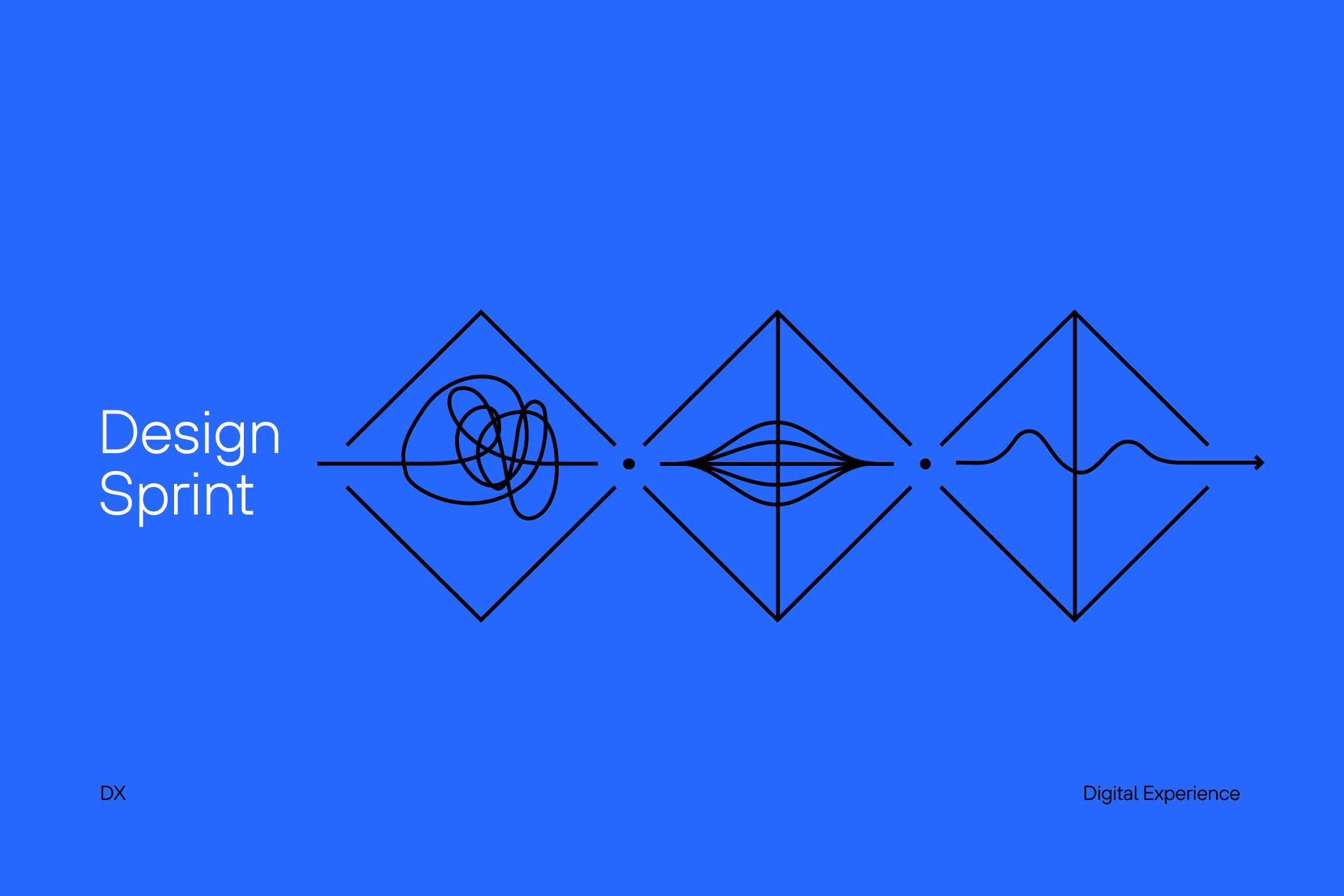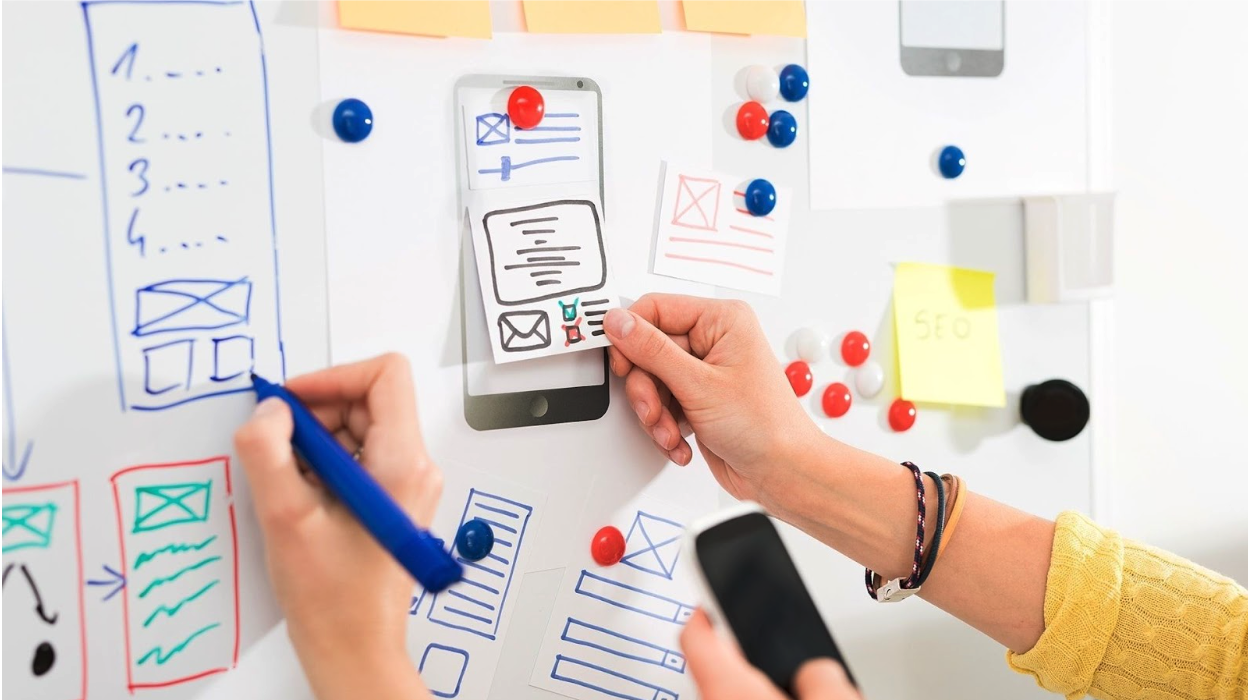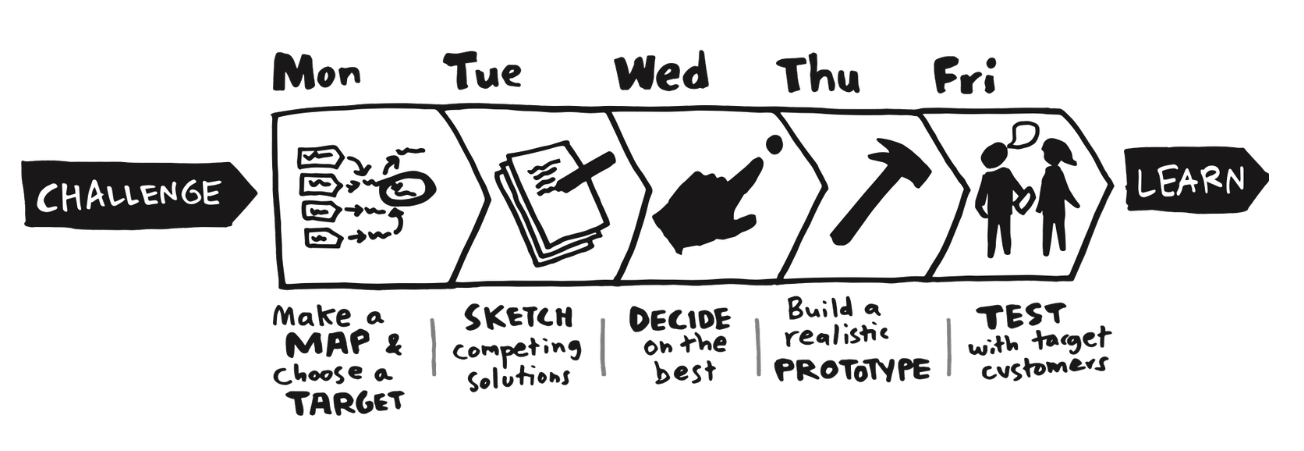
In the fast-paced world of product design and development, effective methods to innovate quickly are essential. That's where the Design Sprint comes into the picture. Created by Jake Knapp at Google Ventures, it's a week full of creativity, collaboration and focus, where a multidisciplinary team solves problems and creates game-changing prototypes. Seems like magic, but it's pure strategy!
In this article, we will explore what the Design Sprint is, how it works, its advantages and why it continues to be a relevant methodology in 2024. Furthermore, we will understand how it can accelerate innovation and the creation of digital products, and what the real value brings to the business. Let's go!
Ok, but what is the Design Sprint?

The book SPRINT written by Jake Knapp is still a bestseller nowadays.
The Design Sprint is a five-day workshop for solving complex problems and testing new ideas quickly. Brings together a multidisciplinary team to understand the problem, create and test prototypes, all within a week.
The Design Sprint is like moving forward in time to see how customers will react to an idea, before investing time and money into creating and developing a new product, service, marketing campaign, or any other initiative.
It is especially useful for validating ideas and reducing risks when developing new products or services.
What happens during the 5 day workshop?

Each day of the Design Sprint has its objective and mission to be accomplished through practical exercises.
Each day has an specific focus, following activities from a co-creation process, ensuring that the team moves forward in a cohesive and efficient way:
Day 1: Understand
On the first day, the team comes together to deeply understand the problem that needs to be solved. This involves mapping the challenge, interviewing experts and setting up clear goals. The idea is for the team to understand the objectives to be achieved and the obstacles that need to be overcome.
Day 2: Ideate
The second day is dedicated to generating ideas. The team have to focus on exploring a wide range of possible solutions. Brainstorming and sketching techniques can be used to ensure that all ideas, however bold, are considered. The goal is to think outside the box and bring different perspectives to the table.
Day 3: Decide
On the third day, the team have to review all the ideas generated and decide which ones have the most potential. Through a process of voting and discussion, the best ideas are selected and refined. At the end of the day, the team have to create a detailed storyboard that will serve as the blueprint for the prototype.
Day 4: Prototype
The fourth day is dedicated to building the prototype. It doesn't have to be perfect or completely functional, but it should be realistic enough to test with users. The team have to work together to create a prototype that represents the chosen solution, using rapid prototyping tools and techniques.
Day 5: Test
On the last day, the prototype is tested with real users. The team have to observe how users interact with the solution and collect valuable feedback. This information is crucial to understanding what works, what needs to be adjusted and what the next steps will be.
But what is the biggest benefit of using the Design Sprint?
When done correctly, a Design Sprint creates a customer-centric problem-solving culture focused on constant innovation.
The biggest benefit of the Design Sprint is the quick validation of ideas. This methodology allows multidisciplinary teams to go from problem to tested solution in just five days, significantly reducing the time and resources needed to evaluate the viability of new ideas and products.
Here are the main aspects of this benefit:
Rapid Validation of Ideas
1. Risk Reduction
The Design Sprint helps mitigate risk by testing and validating concepts before investing large amounts of time and money. By creating prototypes and getting feedback from real users within a week, teams can identify issues and make adjustments quickly, avoiding high development costs and rework.
2. Immediate User Feedback
By testing prototypes with real users at the end of the Sprint, teams receive valuable feedback that can be used to iterate and improve the proposed solution. This immediate feedback helps ensure that the final product meets users' needs and expectations, increasing its chances of success in the market.
3. Development Agility
The Design Sprint speeds up the development process by condensing months of work into one intensive week. This allows companies to be more agile and responsive to market changes, launching products and services in new ways.
4. Focus and Alignment
During the Design Sprint, the team focuses exclusively on the problem to be solved, promoting an environment of collaboration and focus. This helps align all team members around a common goal and make quick, informed decisions.
5. Resource Saving
By avoiding investments in ideas that have not been validated, the Design Sprint saves financial resources and time. This efficient use of resources allows companies to prioritize initiatives that are most likely to succeed.
And when can we use the Design Sprint?
The Design Sprint can be applied in a variety of situations and contexts. Here are some situations where the Design Sprint can be particularly useful:
1. Launch of new products or services:
When a company is about to launch a new product or service on the market, the Design Sprint can be an effective way to validate ideas, identify potential problems, and ensure that the final product meets users' needs. It allows the team to work quickly to develop and test prototypes, ensuring the final product is viable and desirable.
2. Improved user experience (UX):
If a company is experiencing issues with the user experience of its existing product or service, the Design Sprint can be a useful tool for identifying and resolving these issues. By bringing together a multidisciplinary team to analyze and iterate on the user experience, the Design Sprint can help create effective solutions that improve user satisfaction and product usability.
3. Solving specific problems:
When a company faces a specific problem that needs to be resolved quickly, the Design Sprint can be an effective approach. It allows the team to focus on the problem at hand and work collaboratively to generate creative solutions and test them with real users in a short period of time.
4. Exploration of new market opportunities:
If a company is looking to explore new market opportunities or expand into new customer segments, the Design Sprint can be an effective way to test and validate these ideas. It allows the team to quickly create and test prototypes of new products or services, ensuring that the company is investing its resources assertively.
5. Team alignment and goal setting:
The Design Sprint can also be useful for aligning the team around common goals and setting clear goals for a specific project. By bringing the team together for an intensive week of collaborative work, the Design Sprint can help ensure everyone is on the same page and committed to the project's success.
The Value of the Design Sprint for the Business
Cost reduction
The Design Sprint helps to reduce the costs associated with product development in several ways. Firstly, by focusing efforts on an intensive work week, it avoids dispersing resources over an extended period. This means fewer wasted working hours and therefore lower labor costs. Furthermore, by quickly validating ideas and prototypes with real users, the Design Sprint reduces the risk of investing in concepts that don’t resonate with the market, saving resources that would otherwise be spent on developing unnecessary products.
Time-to-Market Acceleration
Speed is essential in the business world, especially in the digital context where trends and user needs can change quickly. The Design Sprint allows companies to take ideas from concept to testing in a short period of time, speeding up the process of developing and launching new products on the market. This means that companies can capitalize on opportunities quickly and respond more quickly and efficiently to market demands.
Increased customer satisfaction
By focusing on the user from the beginning of the development process, the Design Sprint helps companies create products that meet customer needs and expectations. This results in more intuitive, functional and relevant products, which generate greater satisfaction among users. Satisfied customers are more likely to recommend a product to others and remain loyal to the brand, which can lead to increased sales and market share in the long term.
Greater competitiveness
The Design Sprint allows companies to test new ideas and concepts quickly and efficiently, staying ahead of the competition and responding to changes in the market in an agile way. This can help companies gain a leadership position in their industry and stand out from the competition.
Increased team confidence and motivation
By involving team members in a structured and collaborative process, the Design Sprint helps increase team confidence and motivation. The sense of purpose and accomplishment that comes from seeing ideas turn into tangible solutions can be incredibly rewarding for employees, leading to greater productivity and engagement at work.
Why use the Design Sprint?
The Design Sprint offers a structured and efficient approach to solving complex problems and innovating quickly. By condensing the creation, prototyping, and testing process into one week, the Design Sprint saves time and resources that would otherwise be spent on lengthy development cycles. By testing prototypes with real users before investing in full development, companies can identify and resolve problems early, avoiding rework and wasted resources. Furthermore, the Design Sprint encourages a mindset of experimentation and continuous learning, promoting a culture of innovation within the organization.
Is the Method Still Relevant in 2024?
Of course it is! The Design Sprint remains highly relevant in 2024 for several reasons. Competition in the market for digital products and experiences is more intense than ever, and companies that can validate and launch products quickly have a significant competitive advantage. The Design Sprint allows companies to stay ahead of the competition by accelerating the innovation cycle.
The emphasis on user feedback during the Design Sprint ensures that products are developed based on customers' real needs and wants, increasing the likelihood of market success. Furthermore, the Design Sprint can be adapted to a variety of contexts, from startups to large corporations, and for different types of projects, such as product development, services, marketing campaigns and more.
Conclusion:
The Design Sprint emerges as a powerful and highly relevant methodology in today's fast-paced innovation scenario. Its ability to quickly validate ideas, reduce risks, promote team collaboration and save time and resources, makes it an indispensable tool for companies looking to stand out in an increasingly competitive and dynamic market. Whether developing new products, improving user experience or exploring new market opportunities, the Design Sprint offers a clear and efficient path to innovation.
Know more…
If you want to accelerate the creative and design process of digital solutions and experiences, contact Dexa. We are an agency specializing in creating digital experiences, and the Design Sprint is part of one of our offerings, the Innovation Sprint. We use this essential tool to transform ideas into reality, ensuring innovative and effective solutions for your business. Our approach allows you to see tangible results quickly by fostering a customer-centric, problem-solving culture focused on constant innovation. Let us help your company innovate and create digital products with incredible experiences.
